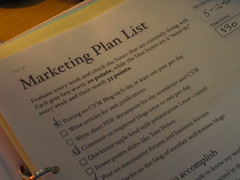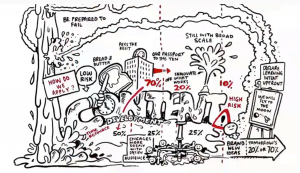
If you ever took an Introduction to Marketing course, you were probably asked to write a marketing plan. The promise of the maketing plan is seductive: if you tick off all of the compulsories – executive summary, situation analysis, SWOT analysis of your competition, objectives and goals, the Four P’s, implementation strategy and measurement – you will generate a guide to marketing success for the next six to twelve months. The problem is, marketing plans don’t work! I’m not sure they ever did, but they sure as hell don’t work now in this rapid-pace, always-on Internet and mobile environment.
Why Marketing Plans Don’t Work
When I worked at Microsoft, every six months we ran the gauntlet of Bill, Steve, Jeff and other executives at fiscal year planning sessions or mid-year reviews. We worked for 6-8 weeks, nearly full-time, on these reviews, and once presented, we never looked at them again.
This is the first reason that marketing plans don’t work: they are written to please executives, not to guide the real, day-to-day work of creating value for customers and the company.
The second reason marketing plans don’t work? You can’t predict the future. If you wrote a marketing plan six to twelve months ago, did you describe your Pinterest strategy? Of course not. Probably, you’d never heard of Pinterest, and if you had, you hadn’t yet figured out how it applied to your business.
This also applies to the competition. Unless you write your competitor’s marketing plan, you can’t predict what they’re going to do, so why bother? It’s better to observe and react quickly to your competitors, or better still, execute so fast that they’re always reacting to you.
The third reason marketing plans don’t work? Customer engagement is a voyage of discovery, and like all voyages of discovery, there is no roadmap. When Lewis and Clark left Pittsburgh on their expedition to explore the Louisiana Purchase, they couldn’t give management (Thomas Jefferson at the time) a plan for their journey. At best, they could tell him that they were going downriver to St. Louis, and they would head north and west from there.
Customer engagement works in the same way. At best, you can tell management about the next destination on your journey, and your general strategy for discovery, but trying to predict the unpredictable is an exercise in futility.
What To Use Instead of a Marketing Plan
Begin by getting agreement on what I call a “marketing model”. I’ve written more extensively about the marketing model in my Introduction to Agile Marketing, but the basic concept is to write down on a single sheet of paper all the key attributes of your market: your target customer segments, their problems and aspirations that you solve or fulfill, your unique value proposition, the key customer touch points and the key metrics.
All of the elements of the marketing model are subject to change, but having this base level of agreement among the members of the marketing team helps generate consistency and focus to your marketing.
Second, establish an iterative approach to your marketing that allows you to quickly try something, measure the results, learn from it, and improve by trying again. This iterative approach is at the heart of Agile Marketing. Each Sprint should include one or more “experiments” that help you iterate to a better understanding of your customers and how you can provide value to them.
The specifics of whether you use Scrum, Kanban, the scientific method, Eric Ries’s Build-Measure-Learn feedback loop or John Boyd’s OODA loop (Observe, Orient, Decide, Act) are not important. What is important is the speed at which you iterate – what I’ve referred to earlier as your innovation metabolism.
So that’s it: stop writing marketing plans, and instead get agreement on the elements of a marketing model, and a rough calendar of the next 2-3 Sprints. Two pages, at most. And make sure that these two pages don’t live in a drawer (where most traditional marketing plans end up), but are published where everyone can see them. They should be living documents, changing frequently as you learn more, and as the market changes.






Well said, Jim — it was good to get your “spin” on this! I’ve been teaching my interns this same thing — a 1 page overview of key revenue model “fulcrums” and things we can experiment with as the future becomes reality.
Well said, Jim — it was good to get your “spin” on this! I’ve been teaching my interns this same thing — a 1 page overview of key revenue model “fulcrums” and things we can experiment with as the future becomes reality.
Thanks, Paul. I’d love to see how you organize your 1 page “fulcrums”. I’ll send you via email my one pager.
Thanks, Paul. I’d love to see how you organize your 1 page “fulcrums”. I’ll send you via email my one pager.
Our small 4 person marketing team has been adopting agile practices. We are working on our 2013 budget now. If you don’t look more than 6 months out how do you plan your budget? Interested in your 1 page plan approach as well. Thanks
Phil,
The budget planning question is a great one. The short answer is that yearly budgets make no more sense than do yearly marketing plans. However, I realize that in many cases, that’s not realistic. So I encourage people to set aside a certain percentage of sales for marketing, reserve some of that money for the things you “must” do (a big annual trade show, for example), and then spend the rest of it according to your Sprint priorities. Even the “must” do’s should have a provable ROI that can be measured.
On the one pager, I’ll send it to you by email. It’s not a one page marketing plan, though, it’s a one-page marketing model. The marketing model encourages the team to write down, in one place on one page, all of the assumptions underlying your marketing: your target customer segments, the problems you solve for them, your value proposition, customer touch points, the most important partners/channels, success metrics for marketing, etc. I find that it’s important to get everyone on the same page before you start writing user stories, which lead to your marketing backlog, which leads to individual sprint backlogs, which are essentially your marketing “plan”. I hope that makes sense.
Our small 4 person marketing team has been adopting agile practices. We are working on our 2013 budget now. If you don’t look more than 6 months out how do you plan your budget? Interested in your 1 page plan approach as well. Thanks
Phil,
The budget planning question is a great one. The short answer is that yearly budgets make no more sense than do yearly marketing plans. However, I realize that in many cases, that’s not realistic. So I encourage people to set aside a certain percentage of sales for marketing, reserve some of that money for the things you “must” do (a big annual trade show, for example), and then spend the rest of it according to your Sprint priorities. Even the “must” do’s should have a provable ROI that can be measured.
On the one pager, I’ll send it to you by email. It’s not a one page marketing plan, though, it’s a one-page marketing model. The marketing model encourages the team to write down, in one place on one page, all of the assumptions underlying your marketing: your target customer segments, the problems you solve for them, your value proposition, customer touch points, the most important partners/channels, success metrics for marketing, etc. I find that it’s important to get everyone on the same page before you start writing user stories, which lead to your marketing backlog, which leads to individual sprint backlogs, which are essentially your marketing “plan”. I hope that makes sense.
Would i be able to get that one pager marketing model please.
Would i be able to get that one pager marketing model please.
Over a 30 year period as a marketing consultant, I have produced a lot of plans for my 3,000+ clients. I ask a new client whether they have a written, up-to-date business plan? Some do, many don’t. Although I know what the answer is likely to be, I then ask whether they have a separate marketing plan? Almost invariably, the answer is, “No, we don’t.” In a fast moving, forever changing world, are marketing plans a waste of time? My experience tells me that that are not.
Shawn, thanks for the comment. In my opinion, a 1-2 page marketing plan can be valuable, but the traditional marketing plan is often outdated by the time it’s done, and it is seldom read if it is too long. The most important thing is to get agreement on the key initiatives, the key levers of change, and what constitutes success.
When I worked at Microsoft, every six months we ran the gauntlet of Bill, Steve, Jeff and other executives at fiscal year planning sessions or mid-year reviews.
Oh yeah! I still have one of those presentations. 157 dense Powerpoint slides.